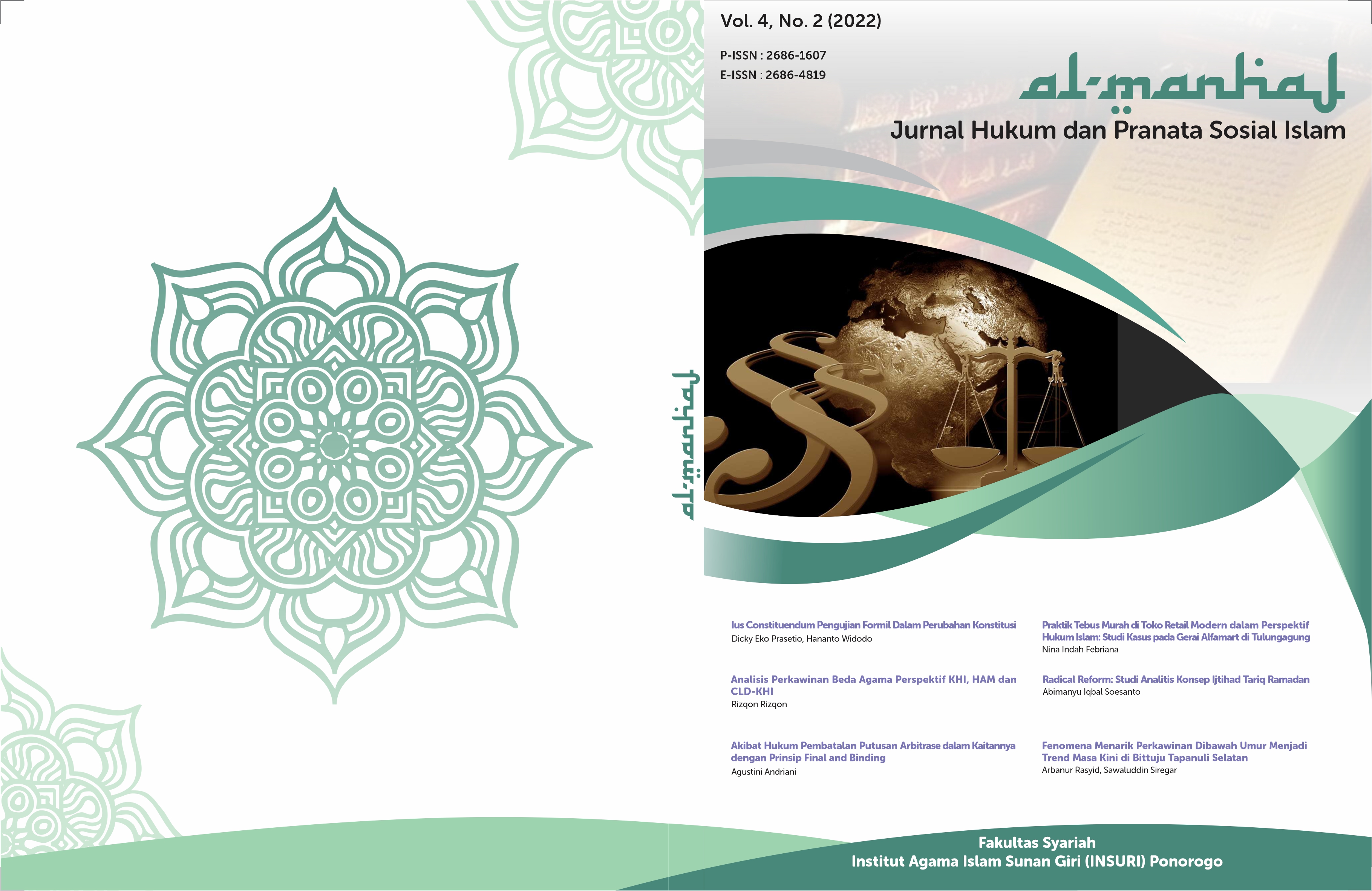Tinjauan Yuridis terhadap Tindak Pidana Persetubuhan dengan Kekerasan pada Anak
DOI:
https://doi.org/10.37680/almanhaj.v4i2.1861Keywords:
child protection; sexsual violence; criminal actAbstract
The Republic of Indonesia, which is based on Pancasila and the 1945 Constitution, always regulates the behavior of its citizens through a series of regulations that are sourced from law. Cases of child sexual intercourse in this country tend to increase. This is one indicator of the poor quality of child protection. Article 20 of Law Number 35 of 2014 amendments to Law Number 23 of 2002 concerning Child Protection states that: "The State, Government, Regional Government, Community, Family, and Parents or Guardians are obliged and responsible for the implementation of Child Protection." Children who are victims of sexual intercourse will suffer material and immaterial losses that can affect their future lives. There needs to be an optimal effort to improve this condition in accordance with Article 2 Paragraph (3) and (4) of the Law of the Republic of Indonesia Number 4 of 1979 concerning Child Welfare, which states that: "Children have the right to care and protection both during pregnancy and after birth". Children have the right to life protections that can harm or hinder normal growth and development. This research is a normative juridical research that describes in detail social phenomena that are the main problems in everyday life associated with applicable positive criminal law regulations. - other symptoms. This study focuses on secondary data sources obtained from primary legal materials, secondary legal materials and tertiary legal materials. Primary legal materials are in the form of laws and regulations outside the Criminal Code relating to criminal law policy issues against crimes committed against children, such as the Law of the Republic of Indonesia Number 23 of 2002 concerning Child Protection, Law Number 11 of 2012 concerning the Juvenile Justice System which renewed by Law no. 35 of 2014
References
Amir Ilyas. 2012. Asas-Asas Hukum Pidana. Yogyakarta: Rangkang Education.
Andi Sofyan.2013. Hukum Acara Pidana,suatu pengantar.Yogyakarta: Mahakarya Rangkang.
Andi Zainal Abidin Farid. 2007. Hukum Pidana 1. Jakarta: Sinar Grafika.Bagong Suyanto.2010. Masalah Sosial Anak.Jakarta: Kencana.
Evi Hartanti. Tindak Pidana Korupsi Edisi Kedua.Jakarta: Sinar Grafika.
Lamintang, P.A.F. 1997. Dasar-Dasar Hukum Pidana Indonesia. Bandung : Citra Aditya Bakti.
Nashriana. 2011. Perlindungan Hukum Pidana Bagi Anak di Indonesia. Jakarta: Rajawali Pers.
R. Soesilo. 1980. Kitab Undang-Undang Hukum Pidana (KUHP) serta Komentar-Komentarnya lengkap Pasal Demi Pasal.Bogor: Politeia.
-----------.1998. Kitab Undang-Undang Hukum Pidana serta Komentar-Komentarnya lengkap Pasal Demi Pasal. Bogor: Politeia.
Sianturi, S.R. 1982. Asas-Asas Hukum Pidana di Indonesia dan Penerapannya. Jakarta: Alumni.
Solihin, L. Tindakan Kekerasan pada Anak dalam Keluarga. Jurnal Pendidikan Penabur. Nomor 03 Desember 2004.
Ira Paramastri. Pencegahan Dini Terhadap Pelecehan Seksual pada Anak-anak. Jurnal Psikologi. Volume 37. Nomor 1 Juni 2010.
Undang-Undang Nomor 35 Tahun 2014 Tentang Perlindungan Anak
Undang-Undang Nomor 23 Tahun 2002 Tentang Perlindungan Anak Undang-Undang Nomor 11 Tahun 2012 Tentang Sistem Peradilan Pidana Anak
Downloads
Published
How to Cite
Issue
Section
License
Copyright:
- Author retains the copyright and grants the journal the right of first publication of the work simultaneously licensed under a Creative Commons Attribution 4.0 International License that allows others to share the work with an acknowledgment of the work's authorship and initial publication in this journal.
- Author is able to enter into separate, additional contractual arrangements for the non-exclusive distribution of the journal's published version of the work (e.g., post it to an institutional repository or publish it in a book) with the acknowledgment of its initial publication in this journal.
- Author is permitted and encouraged to post his/her work online (e.g., in institutional repositories or on their website) prior to and during the submission process, as it can lead to productive exchanges, as well as earlier and greater citation of the published work (See The Effect of Open Access).
License:
-
Attribution — You must give appropriate credit, provide a link to the license, and indicate if changes were made. You may do so in any reasonable manner, but not in any way that suggests the licensor endorses you or your use.
-
No additional restrictions — You may not apply legal terms or technological measures that legally restrict others from doing anything the license permits.
You are free to:
- Share — copy and redistribute the material in any medium or format
- Adapt — remix, transform, and build upon the material for any purpose, even commercially.

This work is licensed under a Creative Commons Attribution 4.0 International License.














